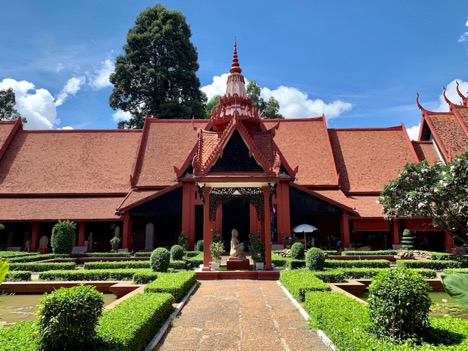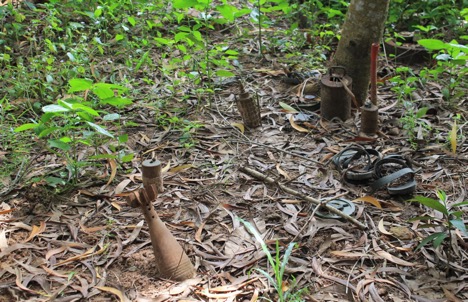Travel Guide to Museums to Visit in Cambodia
Travelers can experience Cambodia's broadened and extensive cultural past. Numerous old temples and structures can be found there, which exhibit the legacy of Hinduism, Buddhism, Jainism, and several other faiths and cultures.
Natural wonders abound in Cambodia, from breathtaking rivers and coastlines to uncharted forests and exotic fauna. Cambodia possesses something for all individuals, irrespective of if they are seeking thrills, pleasure, or knowledge.
With its natural beauty and allure, Cambodia will astound you. One may find themselves in a lively society and heritage that have endured decades of shifts and disruptions there. It is a location where you may learn something novel while also having fun.
Tuol Sleng Genocide Museum
Visit the Tuol Sleng Genocide Museum in Cambodia, one of the most significant and somber sites in Cambodia if you're intrigued in discovering more about the country's past and culture. The museum itself, which additionally serves as a World Heritage Site of UNESCO, was previously a high school that the Khmer Rouge administration turned into a detention center and questioning facility in 1975.
During their cruel four-year dictatorship, hundreds of individuals endured abuse, were slaughtered, and buried in mass graves here.
The museum's displays, which include pictures, drawings, papers, and artifacts, preserve the facts and the tales from this dreadful time. The torture equipment that was used on the detainees, the cells where they were confined, and the blood and tear-stained walls are all visible.
A guided audio tour that recounts the history and soldiers' and victims' testimony is also available. There are numerous language options and no charge to download the audio guide.
Although the Tuol Sleng Genocide Museum in Cambodia isn't recommended for the faint of heart, it will make you understand the tenacity and bravery of the Cambodian people. You will be brought back to both the atrocities of warfare and the value of harmony in this spot. You are driven to find out more about Cambodia's history and current state as well as to support its prospects by visiting this location.
Here are some suggestions to enhance your experience if you intend to stop by the museum in Phnom Penh:
- Take a minimum of two hours exploring the museum. You don't want to skim over everything there is to see and learn since there is a lot to do.
- Be quiet and courteous. Keep in consideration that this constitutes an obituary for the deceased and their loved ones. Don't pose for pictures or snap selfies while standing in front of the exhibitions.
- Bring refreshments and drinking water. You might want to hydrate and replenish because visiting the museum can be emotionally taxing and heated.
- Visit additional Khmer Rouge-related locations like the Choeung Ek Killing Fields, wherein numerous Tuol Sleng captives were put to death, or the Cambodian Living Arts Centre, where you may see cultural performances by survivors of the genocide.
- Consult a regional guide or someone that survived. You can get additional information from them regarding what occurred and the way it influenced Cambodia today.
National Museum of Cambodia, Phnom Penh

The National Museum of Cambodia, which is home to the finest collection of Khmer sculpture in the entire world, is a must-visit location if you enjoy Khmer art and culture.
Just to the north of the Royal Palace in Phnom Penh is where you'll find the National Museum of Cambodia. It was constructed between 1917 and 1920 in the classic terracotta architecture, and the peaceful courtyard garden adds to the peacefulness. More than 14,000 artifacts from prehistoric to contemporary times are kept in the museum, but the Khmer sculpture collection, which displays a millennium's worth of skillful Khmer design, is clearly the centerpiece.
You will be astounded by the variety and intricacy of Khmer art, which shows the impact of native beliefs as well as Buddhism and Hinduism. The Harihara monument, which unites the Hindu deities, Shiva and Vishnu, the grinning Avalokiteshvara figure, which symbolizes the Buddhist bodhisattva of mercy, and the beautiful Apsara dancers that adorn the walls of Angkor Wat are some of the most well-known works.
A wood regal boat of the nineteenth century, antique ceramics and bronzes, as well as modern artwork by Cambodian artists, are among the other intriguing displays in the museum. With markings and audio recordings available in a variety of languages, the museum is well-run and educational. To understand more about the museum and its collection, you can also take a guided tour or view a documentary movie.
One thing to keep in mind is that while taking photos of the museum's outside and courtyard is permitted, doing so is not permitted within the museum's galleries. You must email the facility or speak with an employee to get a request form if you wish to get pictures of the exhibition and the artifacts for research or publishing needs.
The National Gallery of Cambodia is open to the public every day from eight o'clock to five o'clock and entrance costs $5 for visitors from outside of Cambodia and $0.25 for locals. To escape the heat and crowds, it is best to head there first thing in the morning or later in the day. Additionally, you can visit the Royal Palace of Cambodia, the Silver Buddha Pagoda, and Wat Phnom while you're in the area.
Any person who appreciates Khmer art and culture must visit this National Gallery of Cambodia. It will help you understand Cambodia's long and complicated heritage better and urge you to discover more of its beauties.
READ MORE:
In this blog post, we will explore some of the amazing wildlife and nature of Cambodia, highlighting some of the species that are unique, rare, or threatened in this country.
Cambodian Landmine Museum, Siem Reap

Explore the Cambodian Landmine Exhibition if you're curious to learn about the impact and history of landmines in that country. Aki Ra, an ex-youth fighter who devoted his entire existence to uncovering and managing the mines that he had laid during the conflict, built this museum. Additionally, he built a center where poor and landmine-affected kids can get schooling and treatment.
The mines, arms, and other war memorabilia that Aki Ra gathered during his demining labor are on show in the museum. The tales of Aki Ra as well as those impacted by landmines can also be heard through films and audiobooks. The relief facility and ongoing demining activities are the focus of the museum's awareness- and donation-raising initiatives.
Near the museum, there is a relief facility where more than 20 kids from Cambodian rural areas live. Some of them have survived landmines, while others have experienced poverty or abuse. Aki Ra and his spouse offer them nourishment, shelter, clothing, and medical attention as if they were their own children.
In addition to attending regular school, the kids also take additional studies at the facility's school. There, kids have access to a library, an IT lab, an English class, and a play area.
The Cambodian Landmine Museum Organisation (CLMO) and the Cambodian Self Help Demining (CSHD) are two different non-governmental organizations that jointly manage the museum and the relief facility. Utilizing detectors for metal and other instruments, the CSHD oversees detonating landmines around the nation.
The CLMO oversees supervising both the museum and assistance center in addition to lending support to other initiatives aimed at preventing and educating people about landmines.
You can contribute financially or by volunteering your time if you'd like to help the initiatives of these NGOs. Individuals who can assist with teaching English, volunteering in the gallery, or helping with administrative duties are encouraged to apply at the relief facility and the museum.
On their website, you can get further details about what it takes to submit an application. You can improve the well-being of these kids and help create a more secure, more tranquil Cambodia by contributing.
Kampot Museum
Visit the Kampot Museum in Cambodia if you're seeking for a museum that details the history of Kampot, an autonomous region in southern Cambodia. In addition, the museum itself is among the best in Cambodia, but it's additionally one of which is most interesting and educational.
First, the Kampot Museum in Cambodia presents Kampot's culture and past throughout its history, most notably during the Khmer Rouge era and the conflict that followed. You can observe how the residents of Kampot survived, went about their daily lives, and persevered.
Additionally, you can discover more about massacres, opposition movements, and post-conflict situations. The museum features images, records, tools, outfits, and other artifacts depicting Kampot's everyday life.
The Kampot Museum in Cambodia also emphasizes Kampot's history and identity as a unique province of Cambodia.You can investigate Kampot's patterns of settlement, construction, businesses, and culture.
Additionally, you can learn about the cultural influences that various groups had on Kampot, including French colonialists, Chinese commerce, and other nations. On an outline of Cambodia in the museum are depictions of Kampot's limits and physical features at various points in time.
Third, the Kampot Museum in Cambodia is located in a stunning structure that honors the design and engineering of the French colonial era. The French administration constructed the structure in 1925 as a school at first. It has a big courtyard, a wooden staircase, and a tiled roof. Works of art, sculptures, and furnishings that represent the grace and allure of the French past are used to embellish the museum's interior.
Anyone interested in learning about the history of Kampot and Cambodia should visit the Kampot Museum. Every day between eight in the morning to five in the afternoon, it is accessible. For foreign visitors, the entrance cost is $2; for residents, it is $1. For an additional cost, the museum provides audio tours and tours with guides.
War Museum In Cambodia
Visit the War Museum in Siem Reap if you're interested in finding out more about Cambodian history, particularly the dreadful time of the civil war and the Khmer Rouge government. This museum, which houses an array of objects of value, artwork, stone sculptures, and weaponry that were used in battle, is the biggest and most detailed museum in Cambodia. weapons, landmines, rocket launchers, aircraft, and even a combat plane can be seen that were used in the combats.
You can gain a clearer understanding of the reasons behind and effects of the war that ravaged Cambodia for decades by visiting the War Museum there.
Additionally, there are some images that depict the various sides' wartime tactics and strategies. You are supposed brace yourself for some psychological impact because some of these pictures are upsetting and explicit. The War Museum in Cambodia offers the opportunity to hear tales in addition to viewing artifacts. Many of the museum guides are former soldiers or refugees who may share with you their unique insights and stories.
They can share with you the awful things they saw, the difficulties they encountered, and their future aspirations. Anybody who wishes to learn more about Cambodia and admire its resiliency and rehabilitation must visit the War Museum.
READ MORE:
The museums, palaces, pagodas, and markets provide a look into Cambodia's history and culture. Bars, restaurants, and clubs make up its vibrant nightlife. These are only a few of the major towns that contribute to making Cambodia an interesting and varied place to travel. Here is an overview of the most popular cities in Cambodia to visit.
Cambodia Visa Online is an online travel permit to visit Cambodia for tourism or commercial purposes. International visitors must have a Cambodia e-Visa to be able to visit Cambodia. Foreign citizens can apply for an Cambodia e-Visa Application in a matter of minutes.
Australian citizens, Canadian citizens, French citizens and Italian citizens are eligible to apply online for Cambodia e-Visa.